MyCountryandMyPeople两种中译本修辞格翻译对比研究
- 格式:pdf
- 大小:713.45 KB
- 文档页数:3
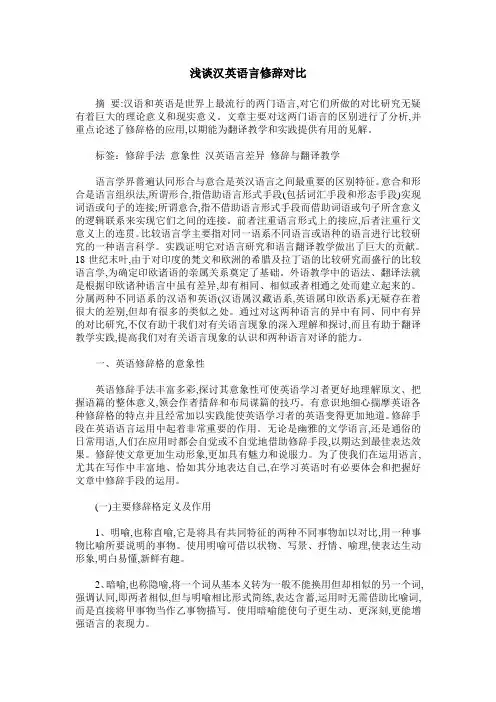
浅谈汉英语言修辞对比摘要:汉语和英语是世界上最流行的两门语言,对它们所做的对比研究无疑有着巨大的理论意义和现实意义。
文章主要对这两门语言的区别进行了分析,并重点论述了修辞格的应用,以期能为翻译教学和实践提供有用的见解。
标签:修辞手法意象性汉英语言差异修辞与翻译教学语言学界普遍认同形合与意合是英汉语言之间最重要的区别特征。
意合和形合是语言组织法,所谓形合,指借助语言形式手段(包括词汇手段和形态手段)实现词语或句子的连接;所谓意合,指不借助语言形式手段而借助词语或句子所含意义的逻辑联系来实现它们之间的连接。
前者注重语言形式上的接应,后者注重行文意义上的连贯。
比较语言学主要指对同一语系不同语言或语种的语言进行比较研究的一种语言科学。
实践证明它对语言研究和语言翻译教学做出了巨大的贡献。
18世纪末叶,由于对印度的梵文和欧洲的希腊及拉丁语的比较研究而盛行的比较语言学,为确定印欧诸语的亲属关系奠定了基础。
外语教学中的语法、翻译法就是根据印欧诸种语言中虽有差异,却有相同、相似或者相通之处而建立起来的。
分属两种不同语系的汉语和英语(汉语属汉藏语系,英语属印欧语系)无疑存在着很大的差别,但却有很多的类似之处。
通过对这两种语言的异中有同、同中有异的对比研究,不仅有助于我们对有关语言现象的深入理解和探讨,而且有助于翻译教学实践,提高我们对有关语言现象的认识和两种语言对译的能力。
一、英语修辞格的意象性英语修辞手法丰富多彩,探讨其意象性可使英语学习者更好地理解原文、把握语篇的整体意义,领会作者措辞和布局谋篇的技巧。
有意识地细心揣摩英语各种修辞格的特点并且经常加以实践能使英语学习者的英语变得更加地道。
修辞手段在英语语言运用中起着非常重要的作用。
无论是幽雅的文学语言,还是通俗的日常用语,人们在应用时都会自觉或不自觉地借助修辞手段,以期达到最佳表达效果。
修辞使文章更加生动形象,更加具有魅力和说服力。
为了使我们在运用语言,尤其在写作中丰富地、恰如其分地表达自己,在学习英语时有必要体会和把握好文章中修辞手段的运用。
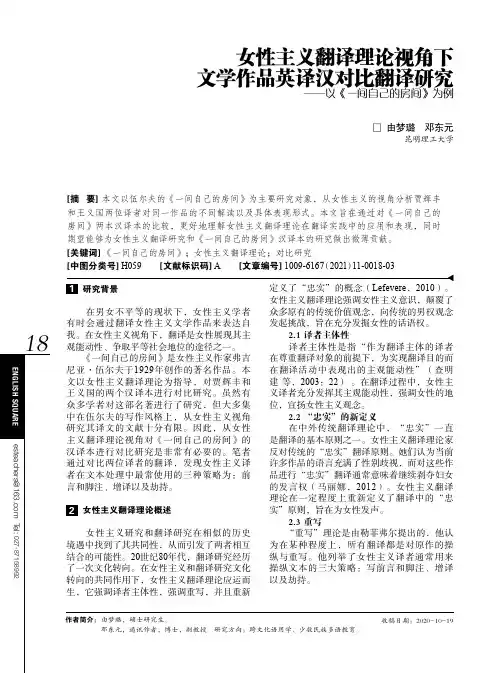
收稿日期:2020-10-19女性主义翻译理论视角下文学作品英译汉对比翻译研究 ——以《一间自己的房间》为例□ 由梦璐 邓东元昆明理工大学[摘 要] 本文以伍尔夫的《一间自己的房间》为主要研究对象,从女性主义的视角分析贾辉丰和王义国两位译者对同一作品的不同解读以及具体表现形式。
本文旨在通过对《一间自己的房间》两本汉译本的比较,更好地理解女性主义翻译理论在翻译实践中的应用和表现,同时期望能够为女性主义翻译研究和《一间自己的房间》汉译本的研究做出微薄贡献。
[关键词] 《一间自己的房间》;女性主义翻译理论;对比研究[中图分类号] H059 [文献标识码] A [文章编号] 1009-6167(2021)11-0018-03作者简介:由梦璐,硕士研究生。
邓东元,通讯作者,博士,副教授。
研究方向:跨文化语用学、少数民族多语教育。
1 研究背景在男女不平等的现状下,女性主义学者有时会通过翻译女性主义文学作品来表达自我。
在女性主义视角下,翻译是女性展现其主观能动性、争取平等社会地位的途径之一。
《一间自己的房间》是女性主义作家弗吉尼亚·伍尔夫于1929年创作的著名作品。
本文以女性主义翻译理论为指导,对贾辉丰和王义国的两个汉译本进行对比研究。
虽然有众多学者对这部名著进行了研究,但大多集中在伍尔夫的写作风格上,从女性主义视角研究其译文的文献十分有限。
因此,从女性主义翻译理论视角对《一间自己的房间》的汉译本进行对比研究是非常有必要的。
笔者通过对比两位译者的翻译,发现女性主义译者在文本处理中最常使用的三种策略为:前言和脚注、增译以及劫持。
2 女性主义翻译理论概述女性主义研究和翻译研究在相似的历史境遇中找到了其共同性,从而引发了两者相互结合的可能性。
20世纪80年代,翻译研究经历了一次文化转向。
在女性主义和翻译研究文化转向的共同作用下,女性主义翻译理论应运而生,它强调译者主体性,强调重写,并且重新定义了“忠实”的概念(Lefevere ,2010)。
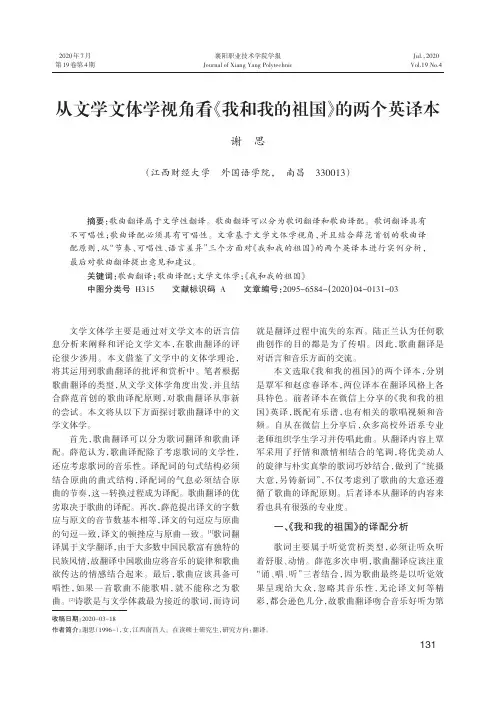
从文学文体学视角看《我和我的祖国》的两个英译本谢思(江西财经大学外国语学院,南昌330013)摘要:歌曲翻译属于文学性翻译。
歌曲翻译可以分为歌词翻译和歌曲译配。
歌词翻译具有不可唱性;歌曲译配必须具有可唱性。
文章基于文学文体学视角,并且结合薛范首创的歌曲译配原则,从“节奏、可唱性、语言差异”三个方面对《我和我的祖国》的两个英译本进行实例分析,最后对歌曲翻译提出意见和建议。
关键词:歌曲翻译;歌曲译配;文学文体学;《我和我的祖国》中图分类号H315文献标识码A文章编号:2095-6584-(2020)04-0131-03收稿日期:2020-03-18作者简介:谢思(1996-),女,江西南昌人。
在读硕士研究生,研究方向:翻译。
文学文体学主要是通过对文学文本的语言信息分析来阐释和评论文学文本,在歌曲翻译的评论很少涉用。
本文借鉴了文学中的文体学理论,将其运用到歌曲翻译的批评和赏析中。
笔者根据歌曲翻译的类型,从文学文体学角度出发,并且结合薛范首创的歌曲译配原则,对歌曲翻译从事新的尝试。
本文将从以下方面探讨歌曲翻译中的文学文体学。
首先,歌曲翻译可以分为歌词翻译和歌曲译配。
薛范认为,歌曲译配除了考虑歌词的文学性,还应考虑歌词的音乐性。
译配词的句式结构必须结合原曲的曲式结构,译配词的气息必须结合原曲的节奏,这一转换过程成为译配。
歌曲翻译的优劣取决于歌曲的译配。
再次,薛范提出译文的字数应与原文的音节数基本相等,译文的句逗应与原曲的句逗一致,译文的顿挫应与原曲一致。
[1]歌词翻译属于文学翻译,由于大多数中国民歌富有独特的民族风情,故翻译中国歌曲应将音乐的旋律和歌曲欲传达的情感结合起来。
最后,歌曲应该具备可唱性,如果一首歌曲不能歌唱,就不能称之为歌曲。
[2]诗歌是与文学体裁最为接近的歌词,而诗词就是翻译过程中流失的东西。
陆正兰认为任何歌曲创作的目的都是为了传唱。
因此,歌曲翻译是对语言和音乐方面的交流。
本文选取《我和我的祖国》的两个译本,分别是覃军和赵彦春译本,两位译本在翻译风格上各具特色。
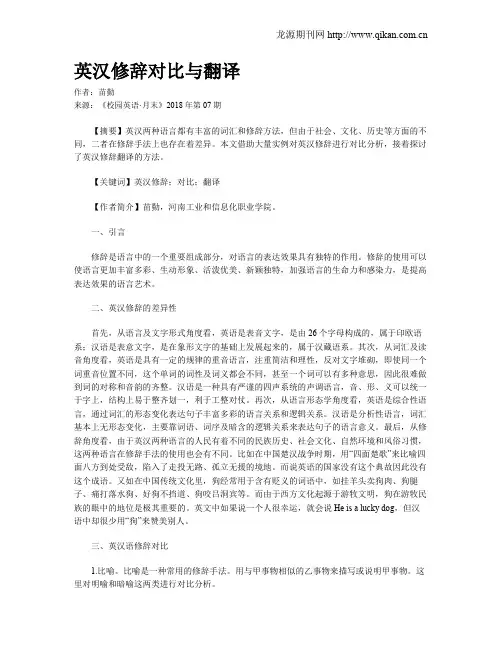
英汉修辞对比与翻译作者:苗勤来源:《校园英语·月末》2018年第07期【摘要】英汉两种语言都有丰富的词汇和修辞方法,但由于社会、文化、历史等方面的不同,二者在修辞手法上也存在着差异。
本文借助大量实例对英汉修辞进行对比分析,接着探讨了英汉修辞翻译的方法。
【关键词】英汉修辞;对比;翻译【作者简介】苗勤,河南工业和信息化职业学院。
一、引言修辞是语言中的一个重要组成部分,对语言的表达效果具有独特的作用。
修辞的使用可以使语言更加丰富多彩、生动形象、活泼优美、新颖独特,加强语言的生命力和感染力,是提高表达效果的语言艺术。
二、英汉修辞的差异性首先,从语言及文字形式角度看,英语是表音文字,是由26个字母构成的,属于印欧语系;汉语是表意文字,是在象形文字的基础上发展起来的,属于汉藏语系。
其次,从词汇及读音角度看,英语是具有一定的规律的重音语言,注重简洁和理性,反对文字堆砌,即使同一个词重音位置不同,这个单词的词性及词义都会不同,甚至一个词可以有多种意思,因此很难做到词的对称和音韵的齐整。
汉语是一种具有严谨的四声系统的声调语言,音、形、义可以统一于字上,结构上易于整齐划一,利于工整对仗。
再次,从语言形态学角度看,英语是综合性语言,通过词汇的形态变化表达句子丰富多彩的语言关系和逻辑关系。
汉语是分析性语言,词汇基本上无形态变化,主要靠词语、词序及暗含的逻辑关系来表达句子的语言意义。
最后,从修辞角度看,由于英汉两种语言的人民有着不同的民族历史、社会文化、自然环境和风俗习惯,这两种语言在修辞手法的使用也会有不同。
比如在中国楚汉战争时期,用“四面楚歌”来比喻四面八方到处受敌,陷入了走投无路、孤立无援的境地。
而说英语的国家没有这个典故因此没有这个成语。
又如在中国传统文化里,狗经常用于含有贬义的词语中,如挂羊头卖狗肉、狗腿子、痛打落水狗、好狗不挡道、狗咬吕洞宾等。
而由于西方文化起源于游牧文明,狗在游牧民族的眼中的地位是极其重要的。
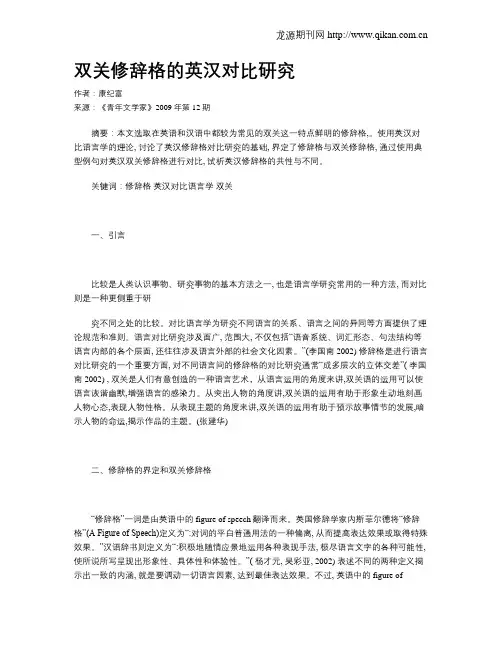
双关修辞格的英汉对比研究作者:康纪富来源:《青年文学家》2009年第12期摘要:本文选取在英语和汉语中都较为常见的双关这一特点鲜明的修辞格,。
使用英汉对比语言学的理论, 讨论了英汉修辞格对比研究的基础, 界定了修辞格与双关修辞格, 通过使用典型例句对英汉双关修辞格进行对比, 试析英汉修辞格的共性与不同。
关键词:修辞格英汉对比语言学双关一、引言比较是人类认识事物、研究事物的基本方法之一, 也是语言学研究常用的一种方法, 而对比则是一种更侧重于研究不同之处的比较。
对比语言学为研究不同语言的关系、语言之间的异同等方面提供了理论规范和准则。
语言对比研究涉及面广, 范围大, 不仅包括“语音系统、词汇形态、句法结构等语言内部的各个层面, 还往往涉及语言外部的社会文化因素。
”(李国南 2002) 修辞格是进行语言对比研究的一个重要方面, 对不同语言间的修辞格的对比研究通常“成多层次的立体交差”( 李国南 2002) , 双关是人们有意创造的一种语言艺术,从语言运用的角度来讲,双关语的运用可以使语言诙谐幽默,增强语言的感染力。
从突出人物的角度讲,双关语的运用有助于形象生动地刻画人物心态,表现人物性格。
从表现主题的角度来讲,双关语的运用有助于预示故事情节的发展,暗示人物的命运,揭示作品的主题。
(张建华)二、修辞格的界定和双关修辞格“修辞格”一词是由英语中的 figure of speech翻译而来。
英国修辞学家内斯菲尔德将“修辞格”(A Figure of Speech)定义为“:对词的平白普通用法的一种偏离, 从而提高表达效果或取得特殊效果。
”汉语辞书则定义为“:积极地随情应景地运用各种表现手法, 极尽语言文字的各种可能性, 使所说所写呈现出形象性、具体性和体验性。
”( 杨才元, 吴彩亚, 2002) 表述不同的两种定义揭示出一致的内涵, 就是要调动一切语言因素, 达到最佳表达效果。
不过, 英语中的 figure of speech 所包括的修辞格是有争议的, 不同的学者依据不同的标准, 将有些修辞手段算作修辞格,有些则排除在外。
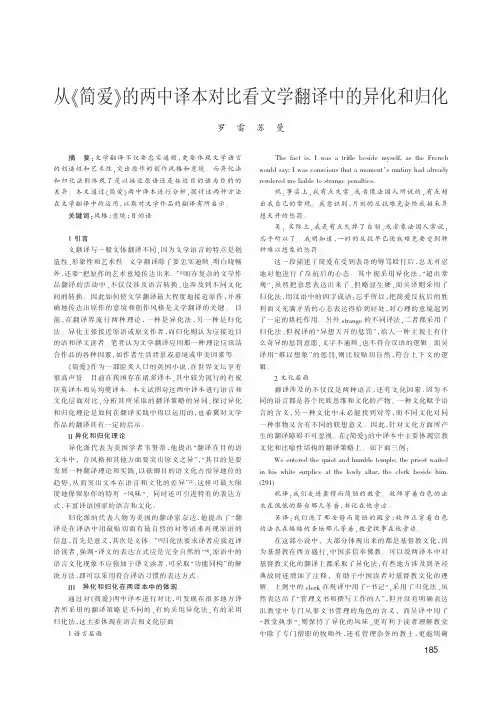
摘要:文学翻译不仅要忠实通顺,更要体现文学语言的创造性和艺术性,突出原作的创作风格和意境。
而异化法和归化法则体现了是以接近原语还是接近目的语为目的的差异。
本文通过《简爱》两中译本进行分析,探讨这两种方法在文学翻译中的运用,以期对文学作品的翻译有所启示。
关键词:风格;意境;目的语1引言文翻译与一般文体翻译不同,因为文学语言的特点是创造性、形象性和艺术性。
文学翻译除了要忠实通顺、明白晓畅外,还要“把原作的艺术意境传达出来。
”[1]而在复杂的文学作品翻译的活动中,不仅仅涉及语言转换,也涉及到不同文化间的转换。
因此如何使文学翻译最大程度地接近原作,并准确地传达出原作的意境和创作风格是文学翻译的关键。
目前,在翻译界流行两种理论,一种是异化法,另一种是归化法。
异化主张接近原语或原文作者,而归化则认为应接近目的语和译文读者。
笔者认为文学翻译应用那一种理论应该结合作品的各种因素,如作者生活背景或意境或审美因素等。
《简爱》作为一部脍炙人口的英国小说,在世界文坛享有很高声誉。
目前在我国存在诸多译本,其中较为流行的有祝庆英译本和吴均燮译本。
本文试图对这两中译本进行语言和文化层面对比,分析其所采取的翻译策略的异同,探讨异化和归化理论是如何在翻译实践中得以运用的,也希冀对文学作品的翻译具有一定的启示。
II异化和归化理论异化派代表为美国学者韦努蒂,他提出“翻译在目的语文本中,在风格和其他方面要突出原文之异”,“其目的是要发展一种翻译理论和实践,以抵御目的语文化占指导地位的趋势,从而突出文本在语言和文化的差异”[2],这样可最大限度地保留原作的特有“风味”,同时还可引进特有的表达方式,丰富译语国家的语言和文化。
归化派的代表人物为美国的翻译家奈达,他提出了“翻译是在译语中用最贴切而有最自然的对等语来再现原语的信息,首先是意义,其次是文体。
”[3]归化法要求译者应接近译语读者,强调“译文的表达方式应是完全自然的”[4],原语中的语言文化现象不应强加于译文读者,可采取“功能同构”的解决方法,即可以采用符合译语习惯的表达方式。
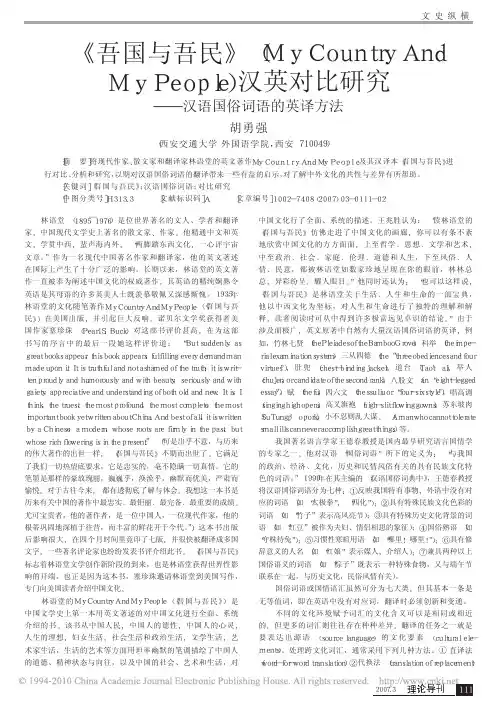
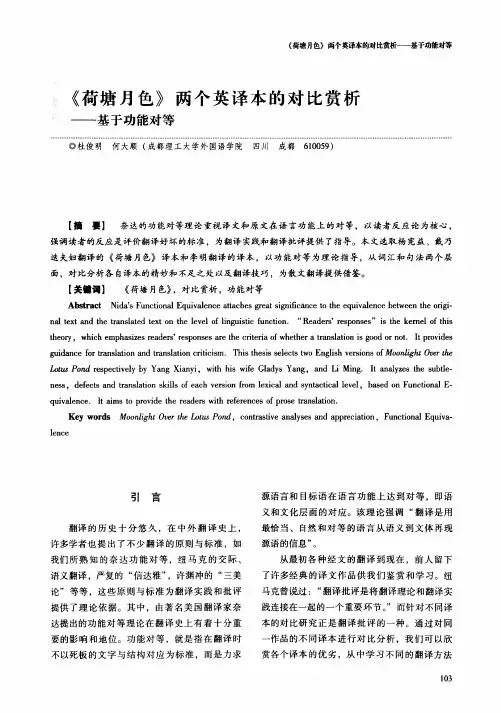
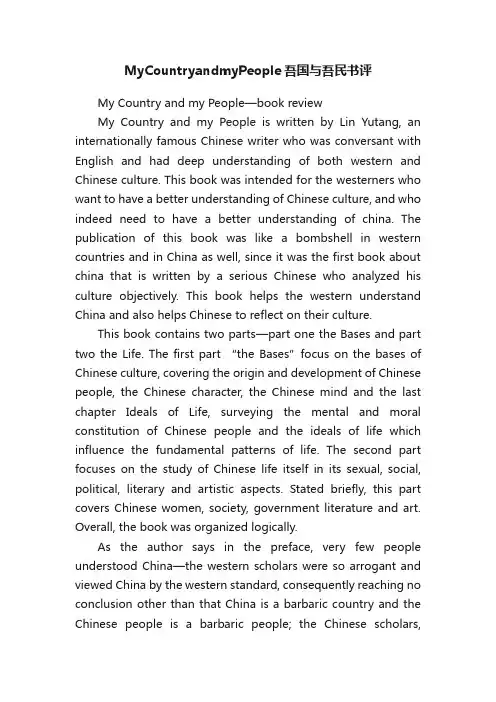
MyCountryandmyPeople吾国与吾民书评My Country and my People—book reviewMy Country and my People is written by Lin Yutang, an internationally famous Chinese writer who was conversant with English and had deep understanding of both western and Chinese culture. This book was intended for the westerners who want to have a better understanding of Chinese culture, and who indeed need to have a better understanding of china. The publication of this book was like a bombshell in western countries and in China as well, since it was the first book about china that is written by a serious Chinese who analyzed his culture objectively. This book helps the western understand China and also helps Chinese to reflect on their culture.This book contains two parts—part one the Bases and part two the Life. The first part “the Bases”focus on the ba ses of Chinese culture, covering the origin and development of Chinese people, the Chinese character, the Chinese mind and the last chapter Ideals of Life, surveying the mental and moral constitution of Chinese people and the ideals of life which influence the fundamental patterns of life. The second part focuses on the study of Chinese life itself in its sexual, social, political, literary and artistic aspects. Stated briefly, this part covers Chinese women, society, government literature and art. Overall, the book was organized logically.As the author says in the preface, very few people understood China—the western scholars were so arrogant and viewed China by the western standard, consequently reaching no conclusion other than that China is a barbaric country and the Chinese people is a barbaric people; the Chinese scholars,however, were the same arrogant and proud, unwilling to admit the weakness of Chinese culture, only writing songs of extolling and defending Chinese culture and their pride. We can borrow two famous words from Jane Austin—pride and prejudice, to characterize the attitudes of these Chinese and western scholars. One typical example of extreme pride is Gu Hongming, a famous Chinese scholar and professor of Peking University, who, though conversant with English, German and many other western language, was extremely conservativeand indiscriminately defended everything of Chinese culture. He was unwilling to cut his little braid long after the overthrow of Qing dynasty and keep it all his life.Except the subjective factors, there were other huge difficulties confronting the scholars in surveying China and Chinese culture—China is so big, with a population of over 400 millions and a vast land over 10 million square kilometer and more than fifty peoples; Chinese culture is so complicated, derived from a five thousand years of uninterrupted history and have no uniform religion that dominant the culture. T o have a real understanding of China an Chinese people, one must travel lots of places around the vast country to witness the Chinese people’s life, the farmers, the citizens, the drudge, the vendors, watching them, listening to them, feeling what they are feeling, thinking what they are thinking; one must also spend time in their studies, reading the Chinese classic books and studying the folk literature. It’s hard for a foreign scholar to do all this, considering the language barriers, the lack of Chinese common sense and the huge cultural gap between China and the west. Comparatively speaking, it is much easier for a Chinese scholar, who is born and raised in China, receiving traditional Chineseeducation and is conversant with both the Chinese classics and folk literature, in one word, he has everything needed to study Chinese culture. But the Chinese scholar must also command scientific method of studying history and culture, which is what the western scholars are good at, and he also need a kind of detachment, that is, he must detach himself from the environment so that he can view the Chinese culture with a cool mind.Before Lin, there were a few attempts made by both Chinese and foreign scholars to view Chinese culture, but none one their works can be called a success. They either view Chinese one-sidedly, or too subjectively. From the failure of the prior efforts of other scholars derived Lin some important lessons and inspirations, the lessons being viewing Chinese culture from a narrow perspective is impossible and subjective or personal emotions are to be avoided when surveying a culture, the inspiration being the possibility of surveying Chinese culture from a macroscopic view.Chapter One The Chinese PeopleChinese people has survived five thousand years, keeping its vitality and integrity and absorbed in many other minority people, while none of her sisters, the other ancient civilized people—ancient Greek, Ancient India and Ancient Babylon—remains alive today. Generally, a people would start going downhill to extinction after reaching its peak. The Greek is a good example, which reached its peak in about the second and third century but quickly fell down in the fourth century. No nation other than China has survived as long as over five thousand years and still remains a young and vital, for they are doomed to degenerate.A race or a people may degenerate both in its physical andspiritual aspects. After reaching the peak, a natural tendency of a race is to be indulgent in all kinds of pleasure, with the army left untrained, the official corrupted and the former aspiration and fighting will nowhere to be found. Neither China nor any other nations can avoid this degeneration, but only China survived.The secret lies in Chinese culture. A fundamental trait of Chinese culture must be moderation, or “the doctrine of gold mean”, which keep remi nding Chinese people do not go to extremes under any circumstance—in times of prosperity, do not over indulgent in pleasure but prepare for the pitfalls instead; in times of adversity, do not be overwhelmed with sadness but took another attitude of life and live on. This is a typical Confucian doctrine, deeply ingrained into every Chinese from gentlemen to farmers.Another cultural characteristic that greatly contributes to the vitality of China is the imperial examination system. It does not only pay a crucial role in the prosperity of culture but also in the stability of the society, because it provides a ladder the unprivileged class, even the poor farmers, with a ladder along which they can climb into the privileged class, thus there is no eternal up-dog, nor eternal underdog, they take turns to rule the country and enjoy the privilege. Simply speaking, this system guaranteed a equality of opportunity, which is vital for the stability of a society.The race remains vital for still another reason—the infusion of new blood. From time to time china was conquered by the northern minority people who are better at fighting, but without exception they only contributed to the revitalization of Chinese people and they are finally conquered by the Chinese culture, readily accepting it and becoming part of it. Every infusion of newblood brought something new to the original culture, especially the vitality of a new and ascendant race. The rich culture and advanced feudalism system was always a great magnet for the surrounding minorities and Chinese people inconvincible culturally.Chapter Two Chinese CharacterMellowness, patience, indifference, old roguery, pacifism, contentment, humor and conservatism are the eight prominent characters of Chinese people. But in the finally they are all originated from a same source—the agricultural economy, or, in still further analysis, the characteristics of natural environment.The mild climate and vast land make it possible the prosperity of agriculture which finally became the dominant economy. The agriculture always requires a peaceful environment, because unlike nomads, farmers must keep closely attending to their farmland in order to get good harvest and guarantee the continuation of production, thus once a war breaks out their production would be interrupted and their surviving would be seriously threatened. So they need peace, and they love peace, diligently working on their farm and patient waiting for the harvest. And only if there is no war and natural disaster, they can always expect a decent harvest, they are quite content with their peaceful life. Thus there is a general contentment, pacifism, and patience in Chinese people’s mind.Agricultural production rarely needs any cooperation in large scale and farming is usually a family activity, and the farmers can completely depend on themselves for food and clothing, not needing much interaction with the rest of the society. As a result, they are often not united and are indifferent to anyone other than their family members, only wars and large governmental projectscan bring them together. And because of the relatively low interaction between social members, there is no need to make and apply strict laws; just moral is enough to bind the social members. In the tightly organized feudalism system, China was always ruled by man instead of by law. The so called of law were applicable only to common people, not to the rulers or the gentry’s class, just as the old Chinese saying goes: courtesy is not extended to the commoners, and punishment is not served up to the lords. The lack of strict law left people’s civil rights unprotected, and consequently they learned to be mellow, old roguery and indifferent, not willing to break the social convention and offend the authority and incur troubles.Chapter Three The Chinese MindA prominent characteristic of Chinese mind is great intelligence. The ordinary Chinese usually have great common sense and wisdom. If you go to a 18th century factory district or slum in the west you are very likely to meet some husky animals with big jaw, low forehead and brute strength. But if you go to the countryside of the Chinatown which is mostly resided by Chinese coolies, you will see a different type, with intelligent eyes and cheerful appearance and eminently reasonable temperament.Chinese people can easily be trained to be highly skilled workers in any field, they are quick learners. Chinese merchant have prospered in the Malay State, in the East Indies, chiefly because their intelligence has been greater than the native, and because of the virtues coming from intelligence, such as thrift, steady industry andfarsightedness. In western countries such as America, Chinese people are referred to as the yellow peril, because theAmerican Chinese people are usually diligent, thrifty and smart, often winning the job opportunity and market from the native people.Intelligent as they are, Chinese minds have several fatal weaknesses—lack of scientific spirit, bad at logic. Overall, Chinese mind is feminine, which are good at common sense and intuition but bad at scientific research and logic. The western know things through experiments, while Chinese know things through intuition of mere contemplating. In spite of a five thousand-year development, China does not have modern mathematics, physics, chemistry, biology and so forth, instead the have Chinese medicine and a Confucian school of idealist philosophy of the Song and Ming Dynasties.The great intelligence of Chinese mind is the result the cultural heritage of five thousand years’ history, while the lack of scientific spirit and logic is a product of the agricultural economy and the Confucian doctrine that slights techniques. There was no impetus or stimulus for the development of techniques and science, and the Confucian doctrine has also hindered or repressed the development science and technology. Though China had an advanced talent selection system, namely the imperial examination system, the examinations only focused on literature and common sense, making no contribution to the development of technology, which was generally thought to be the stuff of the craftsmen who were much inferior to the scholars in social status.In modern times, when the dominant economy of China is no longer agriculture and the Confucian doctrines have long been discarded , Chinese people are catching up with the west in every scientific field with incredible speed, and we have everyreason to believe that in the foreseeable future, China will be playing a leading role in science and technology.(余下几章没来得及完成)。
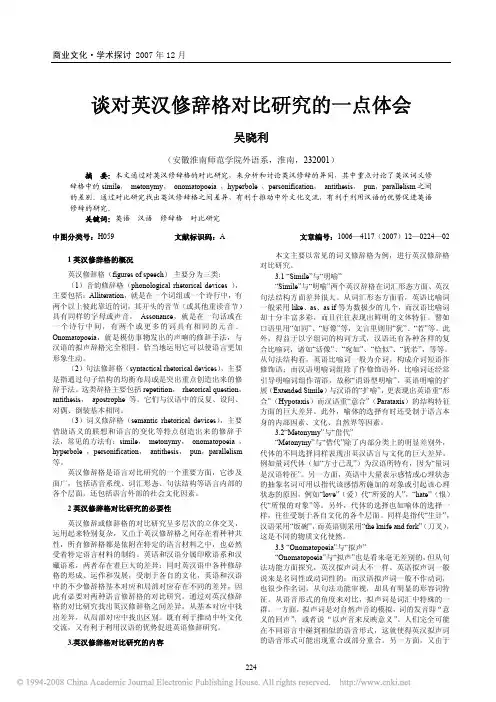
商业文化·学术探讨 2007年12月224谈对英汉修辞格对比研究的一点体会吴晓利(安徽淮南师范学院外语系,淮南,232001)摘 要:本文通过对英汉修辞格的对比研究,来分析和讨论英汉修辞的异同,其中重点讨论了英汉词义修辞格中的simile , metonymy , onomatopoeia ,hyperbole ,personification , antithesis , pun ,parallelism 之间的差别。
通过对比研究找出英汉修辞格之间差异,有利于推动中外文化交流,有利于利用汉语的优势促进英语修辞的研究。
关键词:英语 汉语 修辞格 对比研究 中图分类号:H059 文献标识码:A 文章编号:1006—4117(2007)12—0224—021英汉修辞格的概况英汉修辞格(figures of speech ) 主要分为三类: (1)音韵修辞格(phonological rhetorical devices ),主要包括:Alliteration ,就是在一个词组或一个诗行中,有两个以上彼此靠近的词,其开头的音节(或其他重读音节)具有同样的字母或声音。
Assonance ,就是在一句话或在一个诗行中间,有两个或更多的词具有相同的元音。
Onomatopoeia ,就是模仿事物发出的声响的修辞手法,与汉语的拟声辞格完全相同。
恰当地运用它可以使语言更加形象生动。
(2)句法修辞格(syntactical rhetorical devices ),主要是指通过句子结构的均衡布局或是突出重点创造出来的修辞手法。
这类辞格主要包括repetition , rhetorical question , antithesis , apostrophe 等。
它们与汉语中的反复、设问、对偶、倒装基本相同。
(3)词义修辞格(semantic rhetorical devices ),主要借助语义的联想和语言的变化等特点创造出来的修辞手法,常见的方法有:simile , metonymy , onomatopoeia ,hyperbole ,personification , antithesis , pun ,parallelism 等。
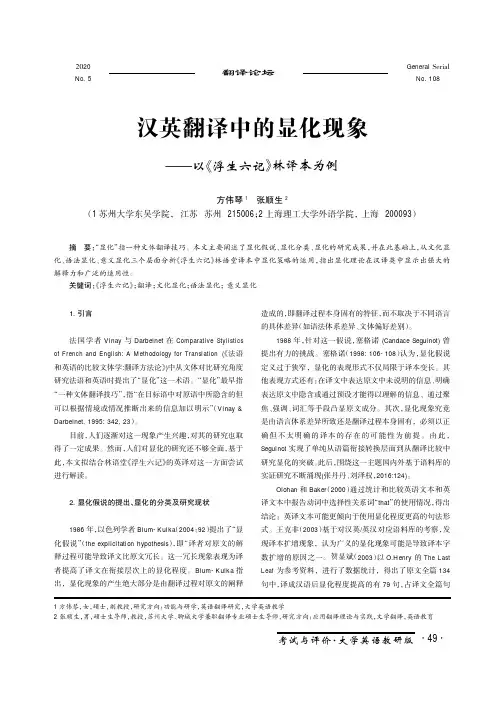
考试与评价·大学英语教研版翻译论坛General Serial No.1082020No.51方伟琴,女,硕士,副教授,研究方向:功能与研学,英语翻译研究,大学英语教学2张顺生,男,硕士生导师,教授,苏州大学、聊城大学兼职翻译专业硕士生导师,研究方向:应用翻译理论与实践,文学翻译,英语教育汉英翻译中的显化现象———以《浮生六记》林译本为例方伟琴1张顺生2(1苏州大学东吴学院,江苏苏州215006;2上海理工大学外语学院,上海200093)摘要:“显化”指一种文体翻译技巧。
本文主要阐述了显化假说、显化分类、显化的研究成果,并在此基础上,从文化显化、语法显化、意义显化三个层面分析《浮生六记》林语堂译本中显化策略的运用,指出显化理论在汉译英中显示出强大的解释力和广泛的适用性。
关键词:《浮生六记》;翻译;文化显化;语法显化;意义显化1.引言法国学者Vinay 与Darbelnet 在Comparative Stylistics of French and English:A Methodology for Translation (《法语和英语的比较文体学:翻译方法论》)中从文体对比研究角度研究法语和英语时提出了“显化”这一术语。
“显化”最早指“一种文体翻译技巧”,指“在目标语中对原语中所隐含的但可以根据情境或情况推断出来的信息加以明示”(Vinay &Darbelnet,1995:342,23)。
目前,人们逐渐对这一现象产生兴趣,对其的研究也取得了一定成果。
然而,人们对显化的研究还不够全面,基于此,本文拟结合林语堂《浮生六记》的英译对这一方面尝试进行解读。
2.显化假说的提出、显化的分类及研究现状1986年,以色列学者Blum-Kulka (2004:92)提出了“显化假说”(the explicitation hypothesis ),即“译者对原文的解释过程可能导致译文比原文冗长。
《吾国与吾民》黄嘉德译本与笔者自译的对比翻译报告作者:高轩来源:《文教资料》2021年第04期摘要:本文通过对比《吾国与吾民》黄嘉德译本与笔者自译,以周领顺教授的译者行为批评理论作为指导,提出在翻译实践中应注意使用多种翻译手法结合,提升文学功底和增加对作品历史背景、文化背景研究等方法提升译者翻译水平的观点。
关键词:《吾国与吾民》翻译对比一、《吾国与吾民》与黄嘉德《吾国与吾民》是林语堂的一部散文集,也是林语堂第一部在美国引起巨大反响的英文著作。
林语堂先生在这本书中用坦率幽默的笔调、睿智通达的语言生动描繪了中国人的道德、精神状态与向往,以及中国人的社会、文艺与生活情趣,用犀利睿智的视角剖析了中华民族的精神和特质,向西方社会展示了真实而丰富的中华民族形象。
黄嘉德(1908—1993),福建晋江潘湖田洋人,著名作家、翻译家、大学教授,笔名蓝萍心、默然。
1908年10月15日生于潘湖田洋。
1931年于上海圣约翰大学英文系毕业,先后担任圣约翰大学助教、副教授、教授、文理学院副院长、文学院副院长等职位。
译作有《萧伯纳传》、萧伯纳的《乡村求爱》等。
1936年至1949年,黄嘉德与弟弟黄嘉音在上海创办西风社,担任主编兼发行人,并聘请林语堂为顾问,出版《西风月刊》《西风副刊》《西书精华》等刊物,积极介绍西方文化。
刘洋通过对比认为黄嘉德译本较多使用口语化表达、成语及四字词组和文化负载词以展现译文词语的丰富性;在句子层面运用较多隐性补偿的手段以增强译文的可读性,反映了译者尽力向读者靠拢的归化翻译策略;在篇章层面讲究对仗工整、平衡对称,凸显了汉语的形式之美,达到了结构紧凑、对称的审美效果[4](35-37)。
林语堂先生在《吾国与吾民》中用坦率幽默的笔调、睿智通达的语言描绘出了中国人的道德、精神状态与向往,以及中国的社会、文艺与生活情趣[5]。
在本书第二章,他用中国人的深刻认识剖析了中国人,分析了中国人的几种性格,把一个人性格的形成与社会环境紧紧相连,认为在社会认同下的部分事物有些看起来是美德,也可能是中国人顽固在根底的恶习。
谈汉英语言中的几种常见修辞现象对比第一篇:谈汉英语言中的几种常见修辞现象对比浅谈汉英语言中的几种常见修辞现象对比A Comparative Study of Rhetoric Between English and Chinese摘要:汉英语言对比,尤其是两种语言中的常用修辞现象的对比,是汉英翻译学习的有效法。
本文就两种语言中最常见,用法又最为相近的几种修辞手段做了详尽的对比。
这些修辞包括比喻中的明喻、暗喻和借喻,还有夸张、拟人和反语。
Abstract: A comparative study of English and Chinese,especially that between figures of speech between the two languages is of great help to leaning translation.This paper makes an extensive study Of the popularly一 used the rhetoric figures in both English and Chinese,including simile,metaphor,metonymy,hyperbole,personification and irony.关键词:修辞对比,暗喻,借喻,夸张,拟人,反语喻体Key words: comparative study of the rhetoric,metaphor,metonymy,Personification,hyperbole,irony,vehicle/image,tenor/object 在通讯技术的发展一日千里的当代世界,相互沟通,相互理解对于创造人类和谐社会显得尤为重要。
语言作为交际的工具,同时也带有各自强烈的文化色彩。
语言的修辞手段更是如此。
它能帮助增强语言的力量,使文字表达更加优美。
古今中外的优秀文学作品都把修辞的美和强烈的表达效果表现的淋漓尽致。
吾国吾民林语堂英文赏析PrefaceMy Country and My People《吾国与吾民》自序By Lin Yutang文/林语堂译/黄嘉德In this book I have tried only to communicate my opinions, which I have arrived at after some long and painful thoughts and reading and introspection. I have not tried to enter into arguments or prove my different theses, but I will stand justified or condemned by this book, as Confucius once said of his Spring and Autumn Annals. China is too big a country, and her national life has too many facets, for her not to be open to the most diverse and contradictory interpretations. And I shall always be able to assist with very convenient material anyone who wishes to hold opposite theses. But truth is truth and will overcome clever human opinions. It is given to man only at rare moments to perceive the truth, and it is these moments of perception that will survive, and not individual opinions. Therefore, the most formidable marshaling of evidence can often lead one to conclusions which are mere learned nonsense. For the presentation of such perceptions, one needs a simpler, which is really a subtler, style. For truth can never be proved; it can only be hinted at.在这一本书里头,我只想发表我自己的意见,这是我经过长时间的苦思苦读和自我省察所收获的,我不欲尝试与人论辩,亦不欲证定我的各项论题,但是我将接受一切批评。
英语中移就修辞手法的辨析及其翻译策略研究朱德红【摘要】移就在英语中是非常重要的修辞格,它一般由转移修饰语和中心词构成.形式上的相似让我们有时候很难将移就和英语中另外两个修辞格拟人和通感区别开来.旨在探讨移就的结构特点、逻辑实质,重点讨论移就与拟人、通感的区别以及移就修辞格的基本翻译策略.【期刊名称】《怀化学院学报》【年(卷),期】2010(029)012【总页数】3页(P113-115)【关键词】移就;特点;区别;翻译【作者】朱德红【作者单位】山东枣庄学院,外语系,山东,枣庄,277160【正文语种】中文【中图分类】H315Abstract:Transferred epithet is one of key figures of speech in English which is generally composed of a transferred modifier and a centre word.Sometimes it is hard to distinguish transferred epithet from personification and synaesthesia because of their superficially similar forms.This paper focuses on discussing the structure,logic,and ways of translation of transferred epithet,as well as its difference frompersonification and synaesthesia.Key words:transferred epitheu; characteristics; differences; translation西方修辞学界把修辞分为交际修辞(Communicative Rhetoric)和美学修辞(Aesthetic Rhetoric)两大版块。